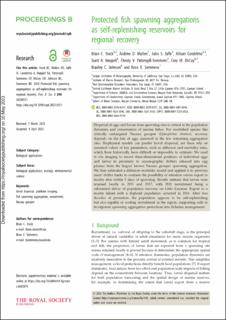| dc.contributor.author | Stock, Brian | |
| dc.contributor.author | Mullen, Andrew D | |
| dc.contributor.author | Jaffe, Jules S | |
| dc.contributor.author | Candelmo, Allison C. | |
| dc.contributor.author | Heppell, Scott A. | |
| dc.contributor.author | Pattengill-Semmens, Christy V. | |
| dc.contributor.author | McCoy, Croy M. | |
| dc.contributor.author | Johnson, Bradley C. | |
| dc.contributor.author | Semmens, Brice X. | |
| dc.date.accessioned | 2023-05-31T11:10:11Z | |
| dc.date.available | 2023-05-31T11:10:11Z | |
| dc.date.created | 2023-05-10T14:13:38Z | |
| dc.date.issued | 2023 | |
| dc.identifier.citation | Proceedings of the Royal Society of London. Biological Sciences. 2023, 290 (1998), 1-11. | en_US |
| dc.identifier.issn | 0962-8452 | |
| dc.identifier.uri | https://hdl.handle.net/11250/3069479 | |
| dc.description.abstract | Dispersal of eggs and larvae from spawning sites is critical to the population dynamics and conservation of marine fishes. For overfished species like critically endangered Nassau grouper (Epinephelus striatus), recovery depends on the fate of eggs spawned at the few remaining aggregation sites. Biophysical models can predict larval dispersal, yet these rely on assumed values of key parameters, such as diffusion and mortality rates, which have historically been difficult or impossible to estimate. We used in situ imaging to record three-dimensional positions of individual eggs and larvae in proximity to oceanographic drifters released into egg plumes from the largest known Nassau grouper spawning aggregation. We then estimated a diffusion–mortality model and applied it to previous years' drifter tracks to evaluate the possibility of retention versus export to nearby sites within 5 days of spawning. Results indicate that larvae were retained locally in 2011 and 2017, with 2011 recruitment being a substantial driver of population recovery on Little Cayman. Export to a nearby island with a depleted population occurred in 2016. After two decades of protection, the population appears to be self-replenishing but also capable of seeding recruitment in the region, supporting calls to incorporate spawning aggregation protections into fisheries management. | en_US |
| dc.language.iso | eng | en_US |
| dc.title | Protected fish spawning aggregations as self-replenishing reservoirs for regional recovery | en_US |
| dc.title.alternative | Protected fish spawning aggregations as self-replenishing reservoirs for regional recovery | en_US |
| dc.type | Peer reviewed | en_US |
| dc.type | Journal article | en_US |
| dc.description.version | publishedVersion | en_US |
| dc.source.pagenumber | 1-11 | en_US |
| dc.source.volume | 290 | en_US |
| dc.source.journal | Proceedings of the Royal Society of London. Biological Sciences | en_US |
| dc.source.issue | 1998 | en_US |
| dc.identifier.doi | 10.1098/rspb.2023.0551 | |
| dc.identifier.cristin | 2146759 | |
| cristin.ispublished | true | |
| cristin.fulltext | original | |
| cristin.qualitycode | 2 | |
